In North Carolina, during the arrival of warblers in spring and summer, yellow birds, including the Yellow-rumped Warbler and American Goldfinch, are commonly seen. However, in winter, these two species are the most frequently spotted yellow birds in the region.
To help you identify the yellow birds you encounter in North Carolina, this guide provides pictures, identification information, song recordings, and details about their migration patterns.
The majority of yellow birds in North Carolina belong to the warbler, oriole, or tanager families. Sometimes, female birds of these species look distinctly different from their male counterparts.
With the comprehensive information provided in this guide, identifying yellow birds will become much easier. The birds are listed in order of their common occurrence in North Carolina during spring and summer, based on ebird checklists for May and June.
Here is a list of yellow birds found in North Carolina throughout the year: American Goldfinch, Pine Warbler, Cedar Waxwing, Eastern Meadowlark, and Baltimore Oriole.
During the summer in North Carolina, you can spot the following yellow birds: Common Yellowthroat, White-eyed Vireo, Summer Tanager, Hooded Warbler, Scarlet Tanager, Yellow-throated Warbler, Black-throated Green Warbler, Prothonotary Warbler, Prairie Warbler, Orchard Oriole, Yellow-throated Vireo, Yellow Warbler, Canada Warbler, and Painted Bunting.
In winter, the commonly sighted yellow birds in North Carolina include: Yellow-rumped Warbler, Palm Warbler, Orange-crowned Warbler, Evening Grosbeak, Western Tanager, Western Kingbird, and Yellow-headed Blackbird.
During migration, you may come across the following yellow birds in North Carolina: American Redstart, Magnolia Warbler, Cape May Warbler, Blue-winged Warbler, Nashville Warbler, Dickcissel, and Wilson’s Warbler.
So, continue reading to learn more about identifying the yellow birds you have spotted.
List of 33 Yellow Birds in North Carolina:
1. American Goldfinch

The American Goldfinch can be observed in North Carolina throughout the year. It is present in 29% of summer and winter checklists submitted by birdwatchers.
These birds are well-known, especially during spring, for their vibrant yellow and black plumage in males. Females and males in winter display a duller brown coloration.
Spinus tristis
Size: 4.3-5.1 inches (11-13 cm)
Weight: 0.4-0.7 ounces (11-20 g)
Wingspan: 7.5-8.7 inches (19-22 cm)
American Goldfinches can be found in various regions of North America and are typically year-round residents. However, those that breed in Canada and the Midwest migrate to southern US states during winter.
You can spot American Goldfinches foraging for sunflower, thistle, and aster plants in weedy fields, overgrown areas, suburbs, parks, and even backyards. They are also attracted to bird feeders with sunflower seed and nyjer seed.
Fun Fact: Cowbirds are unsuccessful in convincing American Goldfinches to raise their young, as the finches’ vegetarian diet is unsuitable for cowbird chicks, leading to their demise within a few days.
2. Yellow-rumped Warbler

Yellow-rumped Warblers are primarily winter birds in North Carolina and are commonly seen from mid-September until May. They are present in 30% of winter checklists.
These warblers have gray plumage with flashes of yellow on the face, sides, and rump, as well as white wings. Female individuals may appear slightly brown in color. During the breeding season, males develop black streaks on their sides and a black throat patch.
Setophaga coronata
Size: 4.7-5.5 inches (12-14 cm)
Weight: 0.4-0.5 ounces (11-14 g)
Wingspan: 7.5-9.1 inches (19-23 cm)
Yellow-rumped Warblers breed in coniferous forests in northern North America and migrate south during winter. In North Carolina, they can be found in a variety of habitats, including woodlands, forest edges, and shrubby areas near water.
These warblers are versatile in their diet, feeding on insects, berries, and small fruits. They can often be seen actively foraging in trees and bushes.
Fun Fact: Yellow-rumped Warblers have a unique adaptation that allows them to digest the waxes found in wax-myrtle and bayberries. This enables them to survive in colder climates during the winter when other food sources are scarce.
3. Pine Warbler
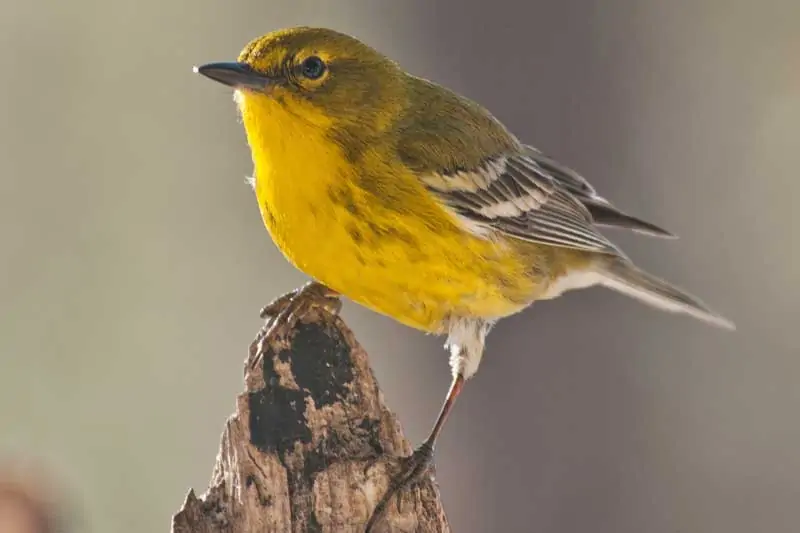
Pine Warblers are common in North Carolina during the breeding season and can be observed from mid-March to early September. They are present in 42% of summer checklists.
These warblers have yellow-green plumage, making them appear mostly yellow. They have thin white wing bars and a slender bill.
Setophaga pinus
Size: 4.7-5.9 inches (12-15 cm)
Weight: 0.3-0.4 ounces (9-11 g)
Wingspan: 8.3-9.1 inches (21-23 cm)
Pine Warblers inhabit pine forests and pine woodlands, where they forage for insects in the tree canopy. They are also known to visit bird feeders for suet and seeds.
During the breeding season, males sing a simple musical trill from high perches to establish their territories.
Fun Fact: Pine Warblers are one of the few warbler species that nest in pine trees, constructing nests from pine needles.
4. Cedar Waxwing
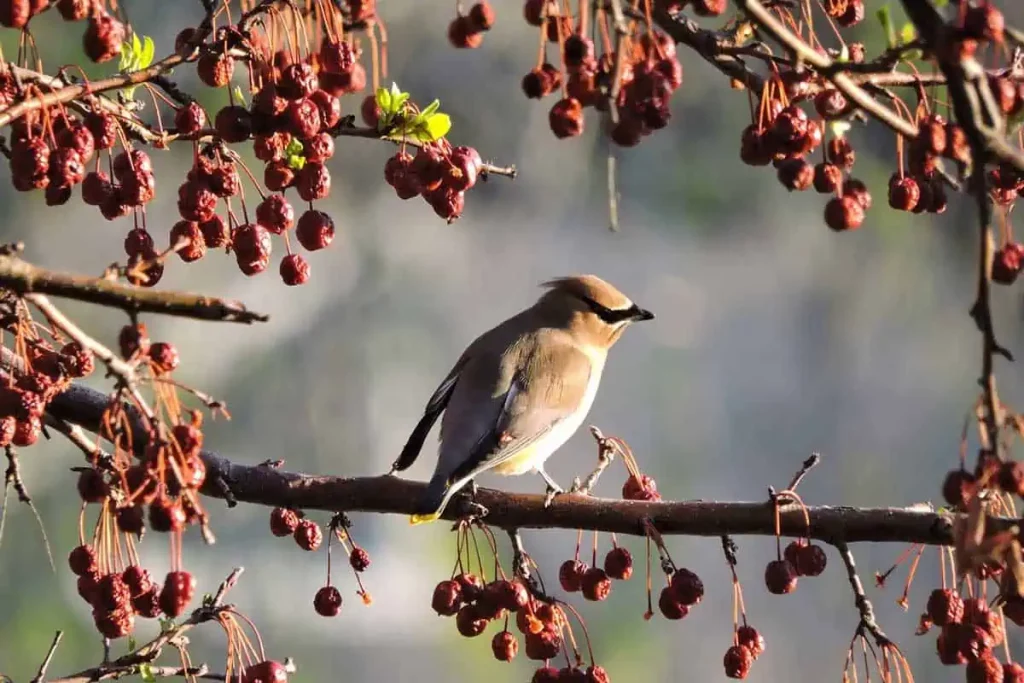
Cedar Waxwings are year-round residents in North Carolina and can be observed in 26% of checklists throughout the year.
These birds have a sleek and smooth appearance, with yellowish bellies, gray-brown backs, and a black mask outlined in white. They also have a small crest on their heads.
Bombycilla cedrorum
Size: 6.7-7.9 inches (17-20 cm)
Weight: 1.1-1.6 ounces (31-45 g)
Wingspan: 11.8-12.6 inches (30-32 cm)
Cedar Waxwings can be found in various habitats, including woodlands, orchards, and suburban areas with fruit-bearing trees. They are known for their social behavior and often travel in large flocks.
These birds primarily feed on fruit, especially berries, and are excellent aerial catchers of insects. They have a distinctive high-pitched whistle call.
Fun Fact: Cedar Waxwings have a unique feeding behavior called “drunkenness.” When they consume fermented fruits, they can become intoxicated, exhibiting uncoordinated movements.
5. Eastern Meadowlark
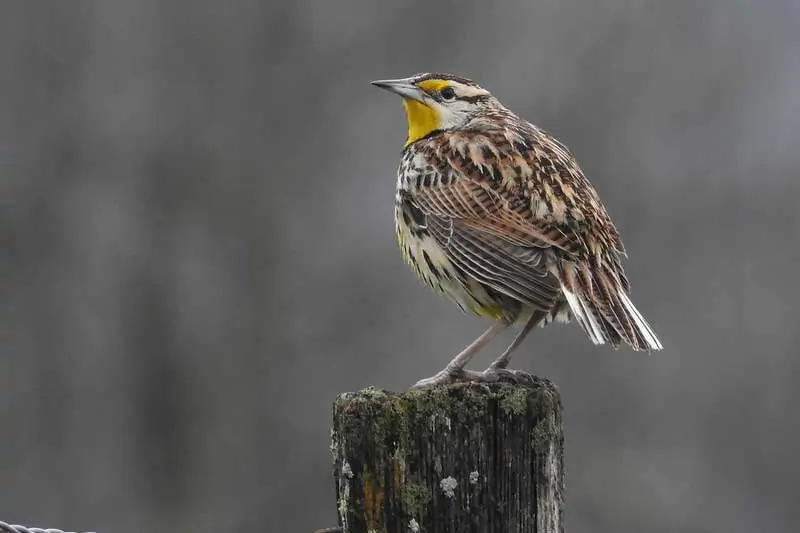
Eastern Meadowlarks are present in North Carolina throughout the year and can be observed in 18% of checklists.
These birds have bright yellow underparts with a black V-shaped bib on their chests. They have brown upperparts with intricate streaking.
Sturnella magna
Size: 8.3-11.0 inches (21-28 cm)
Weight: 4.9-7.3 ounces (140-206 g)
Wingspan: 14.6-16.9 inches (37-43 cm)
Eastern Meadowlarks prefer open grasslands, meadows, and pastures. They are known for their beautiful, melodious songs, often described as a sweet, flute-like whistle.
These birds primarily feed on insects during the breeding season and switch to seeds and grains in the winter. They often forage on the ground, searching for prey in the grassy areas.
Fun Fact: Eastern Meadowlarks have a unique display behavior known as “sky dancing.” Males fly up high and then flutter downward with their wings extended, creating a distinctive visual display while singing.
These are just a few examples of the diverse bird species you can observe in North Carolina. The state’s varied habitats provide a home for numerous bird species, making it a fantastic destination for birdwatching enthusiasts.
6. Red-tailed Hawk

Red-tailed Hawks are large birds of prey commonly found in North Carolina. They have a reddish-brown tail that gives them their name. Adults have dark brown upperparts and a pale underbelly with a distinctive dark belly band.
Buteo jamaicensis
Size: 18.1-25.6 inches (46-65 cm)
Weight: 24.3-51.5 ounces (690-1460 g)
Wingspan: 44.9-52.4 inches (114-133 cm)
These hawks can be seen perched on trees or soaring high in the sky while searching for small mammals, birds, and reptiles as their primary prey. They inhabit a variety of habitats, including forests, open fields, and wetlands.
Fun Fact: Red-tailed Hawks have a piercing scream-like call that is often associated with their presence.
7. Great Blue Heron
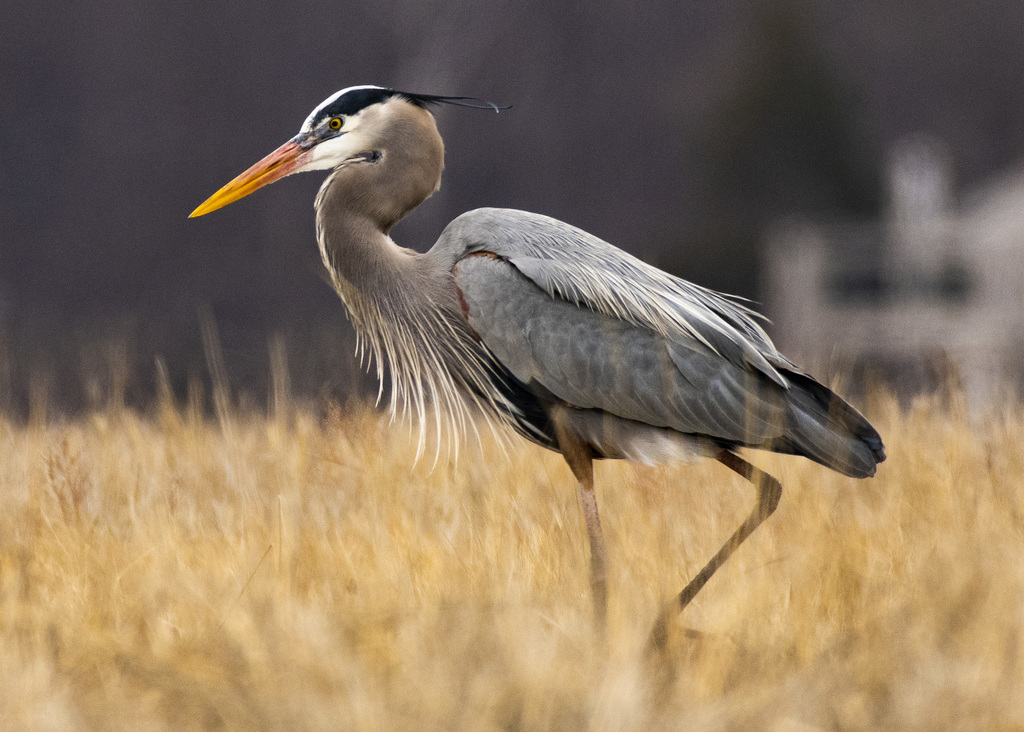
The Great Blue Heron is a large wading bird commonly found in wetland habitats throughout North Carolina. They have a tall stature, long legs, and a long, S-shaped neck.
Ardea herodias
Size: 38.2-54.3 inches (97-138 cm)
Weight: 66.1-88.2 ounces (1875-2500 g)
Wingspan: 66.1-72.4 inches (168-184 cm)
These herons have blue-gray plumage with a white face and a black stripe extending from their eye to the back of their head. They feed on a variety of prey, including fish, frogs, small mammals, and insects.
Great Blue Herons are often seen wading in shallow waters, patiently waiting for their prey. Their slow and deliberate movements make them excellent hunters.
Fun Fact: Great Blue Herons build large stick nests in trees, typically near water bodies. These nests can reach sizes of up to four feet in diameter.
8. Northern Cardinal
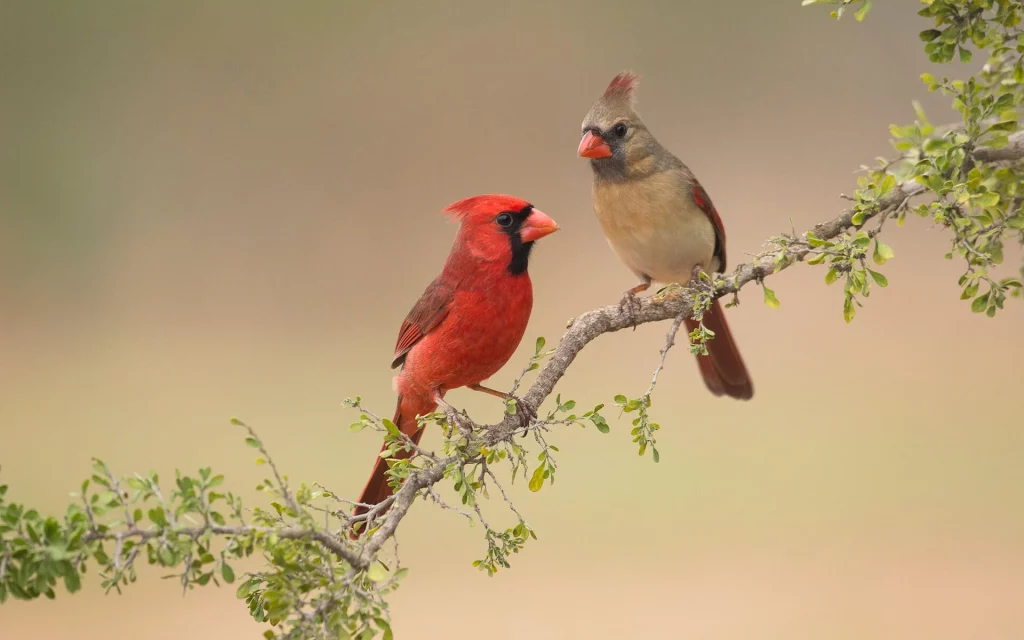
The Northern Cardinal is a familiar and colorful bird species found throughout North Carolina. Males have bright red plumage, while females have a more muted combination of grayish-brown and red.
Cardinalis cardinalis
Size: 8.3-9.1 inches (21-23 cm)
Weight: 1.5-1.7 ounces (42-48 g)
Wingspan: 9.8-12.2 inches (25-31 cm)
These birds are known for their distinctive crest and strong, conical bills. They inhabit a variety of habitats, including woodlands, gardens, and suburban areas.
Northern Cardinals primarily feed on seeds, fruits, and insects. They are frequent visitors to backyard feeders, where they delight bird enthusiasts with their bright presence and melodic songs.
Fun Fact: Male Northern Cardinals are known for their territorial behavior. They fiercely defend their breeding territories and can be seen vigorously defending their reflection in windows or mirrors.
These additional species add to the richness and diversity of birdlife found in North Carolina. Whether you’re a seasoned birder or a beginner, there’s always something fascinating to discover while exploring the avian world in this beautiful state.
9. Eastern Bluebird
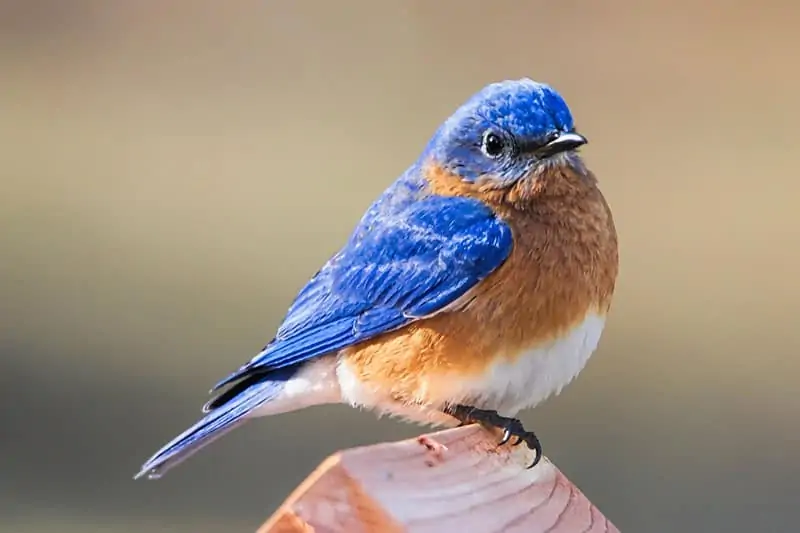
The Eastern Bluebird is a small, colorful thrush species that is a symbol of happiness and good fortune. They have a blue back, reddish-brown breast, and white underparts.
Sialia sialis
Size: 6.3-8.3 inches (16-21 cm)
Weight: 0.95-1.1 ounces (27-30 g)
Wingspan: 9.8-12.2 inches (25-31 cm)
Eastern Bluebirds are cavity nesters, often utilizing natural tree cavities or nest boxes. They primarily feed on insects and berries and can be found in open areas with scattered trees, such as meadows, parks, and golf courses.
Fun Fact: Eastern Bluebirds are a favorite among bird enthusiasts due to their vibrant colors and cheerful songs. Their population has been recovering thanks to conservation efforts, including the provision of nest boxes.
10. Brown Pelican
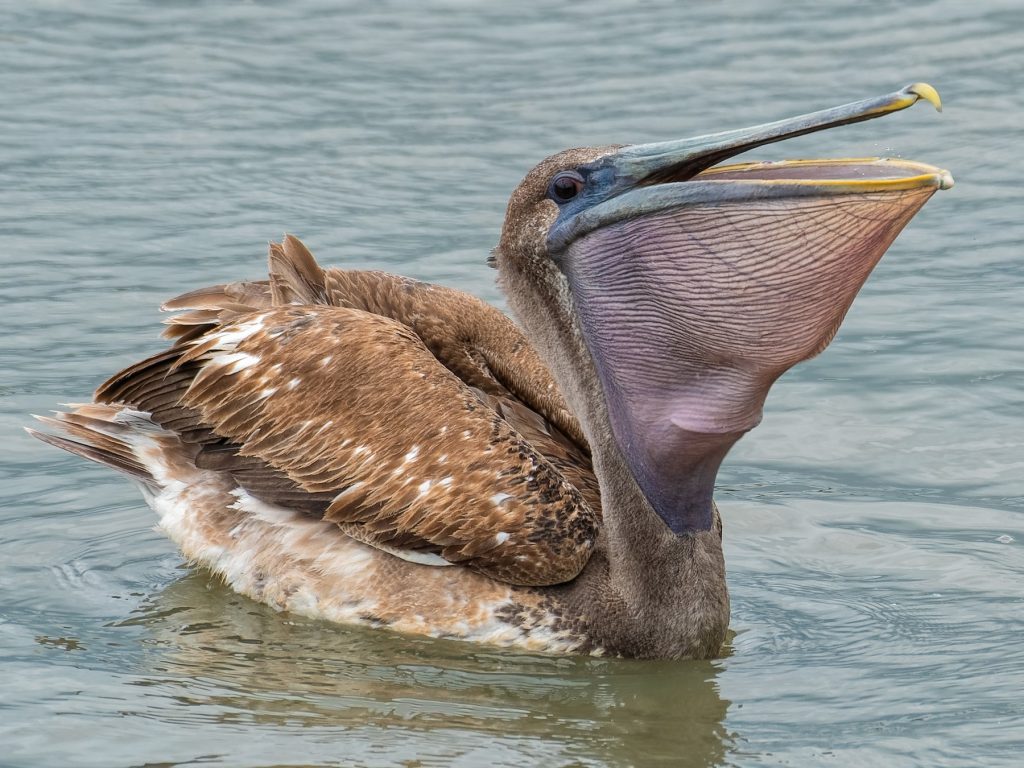
The Brown Pelican is a large seabird that can be found along the coast of North Carolina. They have a distinctively long bill and a large throat pouch used for catching fish.
Pelecanus occidentalis
Size: 42.5-54.3 inches (108-138 cm)
Weight: 84.7-110.2 ounces (2400-3120 g)
Wingspan: 79.9-90.6 inches (203-230 cm)
Brown Pelicans are excellent divers and plunge into the water from heights of up to 60 feet to catch their prey. They primarily feed on fish, scooping them up with their bill and pouch.
Fun Fact: The Brown Pelican was listed as an endangered species in the 1970s due to the impacts of DDT pesticide on their eggs. Since the ban of DDT and subsequent conservation efforts, their population has recovered, and they are now a common sight along the coastlines.
11. Carolina Chickadee
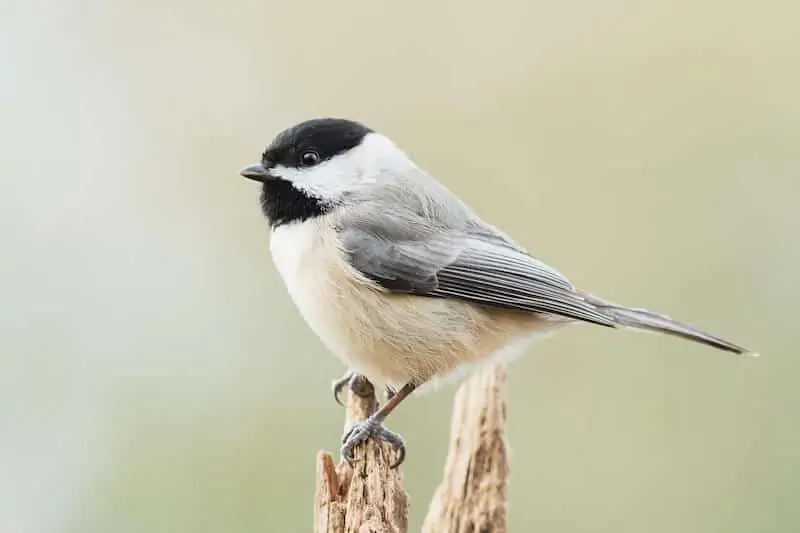
The Carolina Chickadee is a small, lively songbird that can be found in wooded areas of North Carolina. They have a distinctive black cap, white cheeks, and grayish-brown back with a lighter underbelly.
Poecile carolinensis
Size: 4.7-5.5 inches (12-14 cm)
Weight: 0.32-0.49 ounces (9-14 g)
Wingspan: 7.5-8.7 inches (19-22 cm)
Carolina Chickadees are active and social birds, often seen in small flocks. They have a variety of vocalizations, including their famous “chick-a-dee-dee-dee” call.
Fun Fact: Carolina Chickadees are cavity nesters and excavate their own nesting holes. They are known to use old woodpecker holes or nest boxes as well.
These are just a few more examples of the diverse bird species that can be found in North Carolina. The state offers rich habitats for birds, from coastal areas to woodlands, providing ample opportunities for birdwatchers and nature enthusiasts to observe and appreciate these remarkable creatures.
12. Red-tailed Hawk

The Red-tailed Hawk is a large, broad-winged hawk species known for its reddish-brown tail. They have a wingspan of over four feet and are often seen soaring high above open fields and woodlands.
Buteo jamaicensis
Size: 18.1-25.6 inches (46-65 cm)
Weight: 24.3-51.5 ounces (690-1460 g)
Wingspan: 44.9-52.4 inches (114-133 cm)
Red-tailed Hawks are skilled hunters and primarily feed on small mammals, birds, and reptiles. They have a distinctive scream-like call that is often associated with the sound of a soaring hawk.
Fun Fact: Red-tailed Hawks are known for their remarkable eyesight, capable of spotting prey from great distances. They also exhibit a variety of color variations, with some individuals having dark brown or nearly white plumage.
13. Northern Cardinal

The Northern Cardinal is a medium-sized songbird known for its bright red plumage and prominent crest on its head. They are a common sight in backyards and gardens across North Carolina.
Cardinalis cardinalis
Size: 8.3-9.3 inches (21-23.5 cm)
Weight: 1.5-1.7 ounces (42-48 g)
Wingspan: 9.8-12.2 inches (25-31 cm)
Northern Cardinals are known for their melodious song and are popular birds among birdwatchers. The males have vibrant red feathers, while the females have a more subdued reddish-brown color.
Fun Fact: Northern Cardinals are known to be monogamous, often forming long-lasting pairs. They are also year-round residents in North Carolina, providing colorful beauty to the winter landscape.
14. Wood Duck

The Wood Duck is a stunningly beautiful waterfowl species that can be found in wetland areas and wooded swamps across North Carolina. They are known for their striking plumage and unique crested head.
Aix sponsa
Size: 17-20 inches (43-51 cm)
Weight: 1-1.6 pounds (455-680 g)
Wingspan: 26-29 inches (66-74 cm)
Wood Ducks nest in tree cavities near water bodies and feed on seeds, fruits, insects, and small aquatic creatures. They are highly agile and can often be seen perching on tree branches or swimming in shallow waters.
Fun Fact: Wood Ducks are one of the few duck species that have sharp claws on their feet, allowing them to perch on branches. They are also known to have one of the highest cavity-nesting success rates among birds.
These are just a few more examples of the diverse bird species that can be found in North Carolina. The state offers a wide range of habitats, from wetlands to woodlands, providing ample opportunities to observe and appreciate the fascinating birdlife in the region.
15. Eastern Bluebird
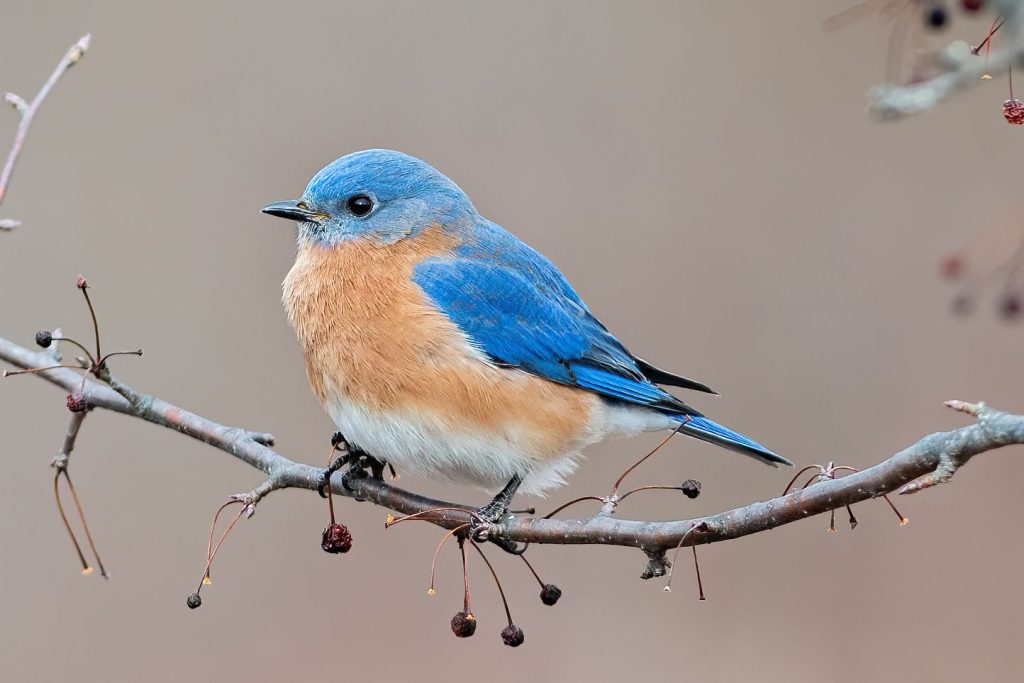
The Eastern Bluebird is a small thrush species with a vibrant blue back and a rusty-orange breast. They are commonly found in open woodlands, fields, and along the edges of forests.
Sialia sialis
Size: 6.3-8.3 inches (16-21 cm)
Weight: 1.1-1.2 ounces (30-34 g)
Wingspan: 9.8-12.2 inches (25-31 cm)
Eastern Bluebirds are cavity nesters and are often seen perching on fences or low branches, searching for insects and small fruits. They have a sweet, warbling song that adds a delightful melody to their surroundings.
Fun Fact: Eastern Bluebirds are a conservation success story. Their populations have rebounded thanks to the installation of nest boxes, which provide additional nesting sites for these cavity-nesting birds.
16. Brown Pelican
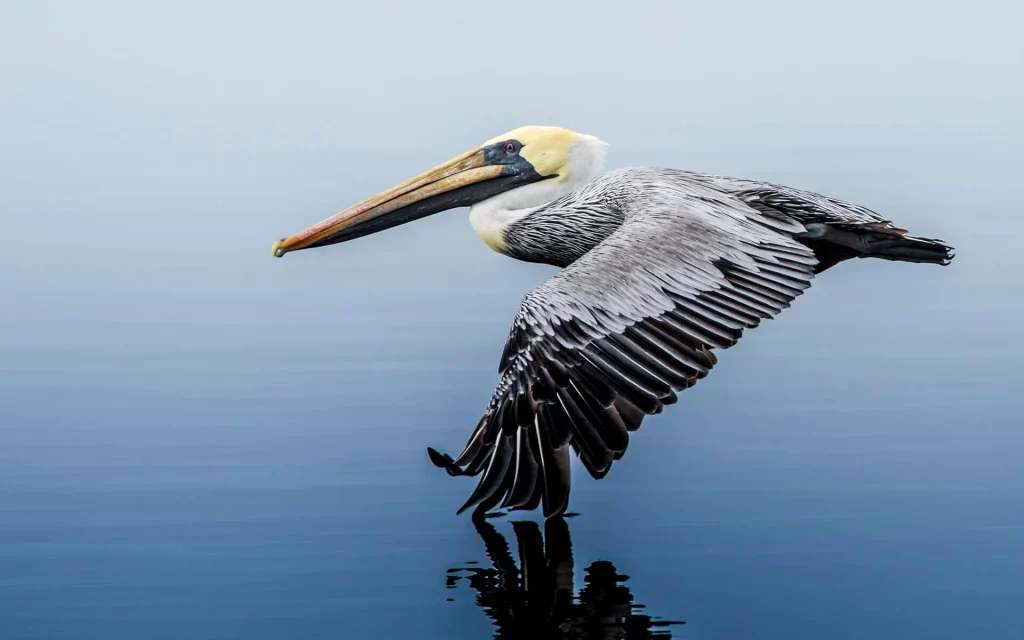
The Brown Pelican is a large waterbird with a distinctive long bill and a pouch-like throat. They can be found along the coastlines of North Carolina, especially near estuaries and barrier islands.
Pelecanus occidentalis
Size: 42.9-54.3 inches (109-138 cm)
Weight: 6.1-11.0 pounds (2.8-5.0 kg)
Wingspan: 79.9-90.6 inches (203-230 cm)
Brown Pelicans are excellent divers and plunge into the water from high above to catch fish. They are known for their impressive aerial acrobatics and their ability to form large groups while foraging.
Fun Fact: The Brown Pelican is the official state bird of Louisiana, but it can also be spotted in coastal areas of North Carolina during certain times of the year.
17. Painted Bunting
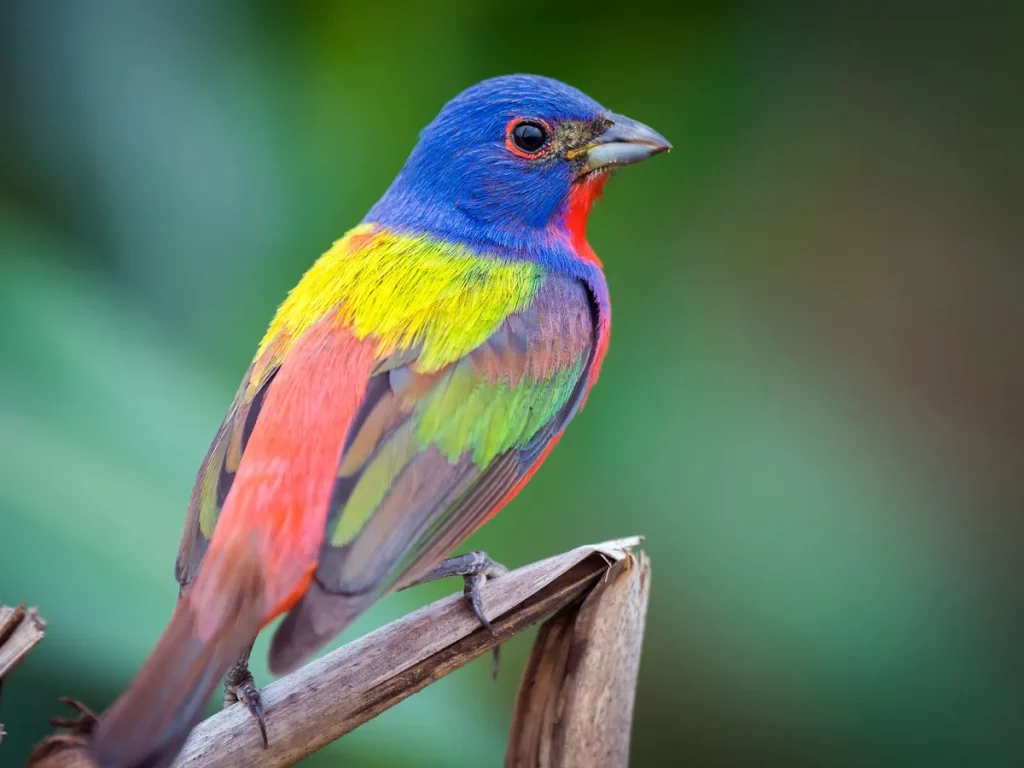
The Painted Bunting is a small, colorful songbird that can be found in the eastern parts of North Carolina during the breeding season. The males are particularly striking, with bright blue heads, red breasts, and green backs.
Passerina ciris
Size: 4.7-5.5 inches (12-14 cm)
Weight: 0.6-0.9 ounces (17-25 g)
Wingspan: 7.1-8.3 inches (18-21 cm)
Painted Buntings inhabit shrubby habitats, including overgrown fields, brushy areas, and woodland edges. They primarily feed on seeds but also consume insects during the breeding season.
Fun Fact: The male Painted Bunting is often described as one of the most beautiful birds in North America due to its vibrant and contrasting plumage colors.
These are just a few more examples of the diverse bird species that can be found in North Carolina. Whether you’re a seasoned birdwatcher or a casual observer, North Carolina offers a rich avian diversity that is sure to captivate and inspire.
18. Yellow-throated Vireo
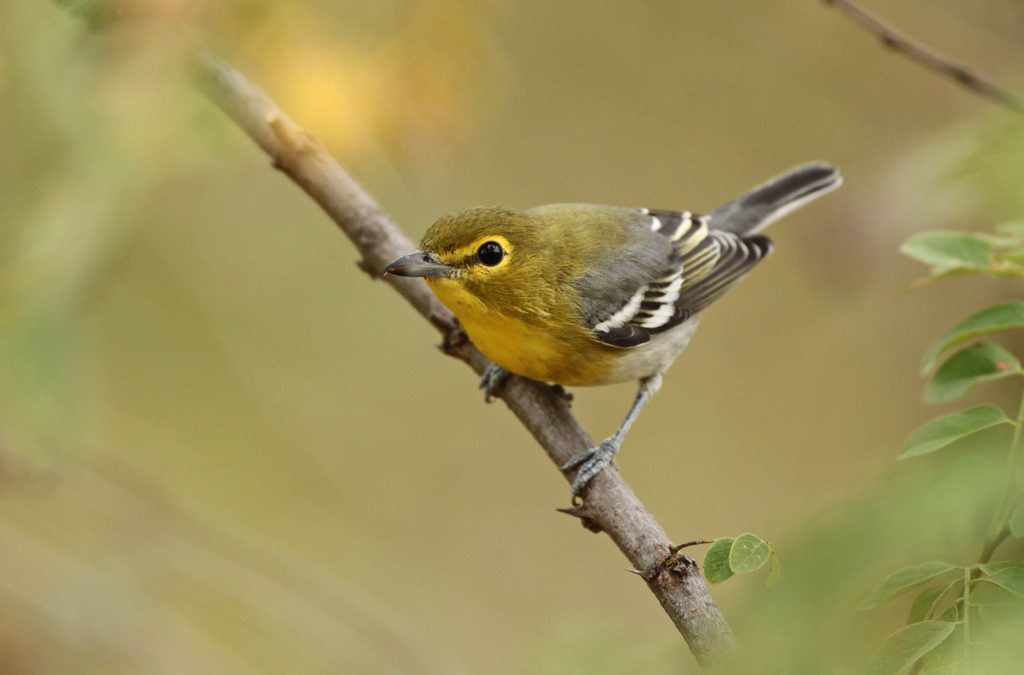
In North Carolina, from March to November, Yellow-throated Vireos can be spotted, recorded in 3% of summer checklists.
Gray and olive-colored heads complement the bright yellow throats and chests of these Yellow-throated Vireos. Their grayish-brown backs feature white streaks, and they possess white bellies.
Vireo flavifrons
Size: 5.1-5.9 in (13-15 cm)
Weight: 0.5-0.7 oz (15-21 g)
Wingspan: 9.1 in (23 cm)
Eastern US states serve as breeding grounds for Yellow-throated Vireos, while they spend the winter in Central and South America and the Caribbean.
Yellow-throated Vireos forage for insects and occasionally berries, often seen hunting in mixed woodlands.
The hanging nests of Yellow-throated Vireos are constructed high in trees. Composed of bark, grass, pine needles, and other plant materials, the nests are secured with spider webs and insect silk.
Four eggs are laid in the nest and take approximately two weeks to hatch, followed by an additional two weeks before the young leave the nest.
Fun Fact: Male Yellow-throated Vireos engage in a unique behavior of creating little piles of twigs to attract females, mimicking nest-building activities.
19. Magnolia Warbler
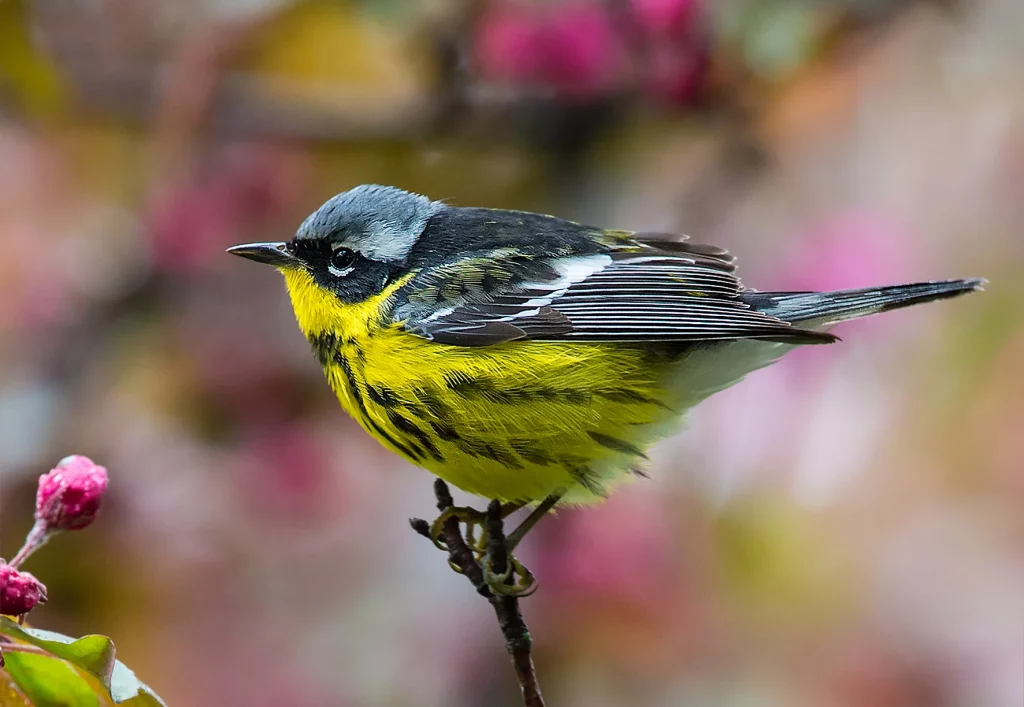
During spring and fall migration (May, September to October), Magnolia Warblers can be found in North Carolina.
Males of the Magnolia Warbler species feature black backs and yellow undersides with black streaks forming a distinctive “necklace” pattern. Females have grayer backs and lack the pronounced streaking on their bellies.
Setophaga magnolia
Size: 4.3-5.1 in (11-13 cm)
Weight: 0.2-0.5 oz (6-15 g)
Wingspan: 6.3-7.9 in (16-20 cm)
Magnolia Warblers breed in Canada and northeastern US states. During migration, they traverse the eastern US, while their winter months are spent in Central America and the Caribbean.
Forests, parks, and woodland edges provide suitable habitats for Magnolia Warblers. They primarily feed on insects and spiders.
Magnolia Warblers construct their nests close to the trunk of conifer trees, using grass and weeds as their primary building materials. They lay about four eggs, which take approximately twelve days to hatch, followed by nine days for the young to leave the nest.
To attract Magnolia Warblers to your backyard, consider planting native shrubs and trees that offer rest spots during migration.
Fun Fact: Male Magnolia Warblers display their white tail spots to attract mates and ward off rivals.
20. Cape May Warbler
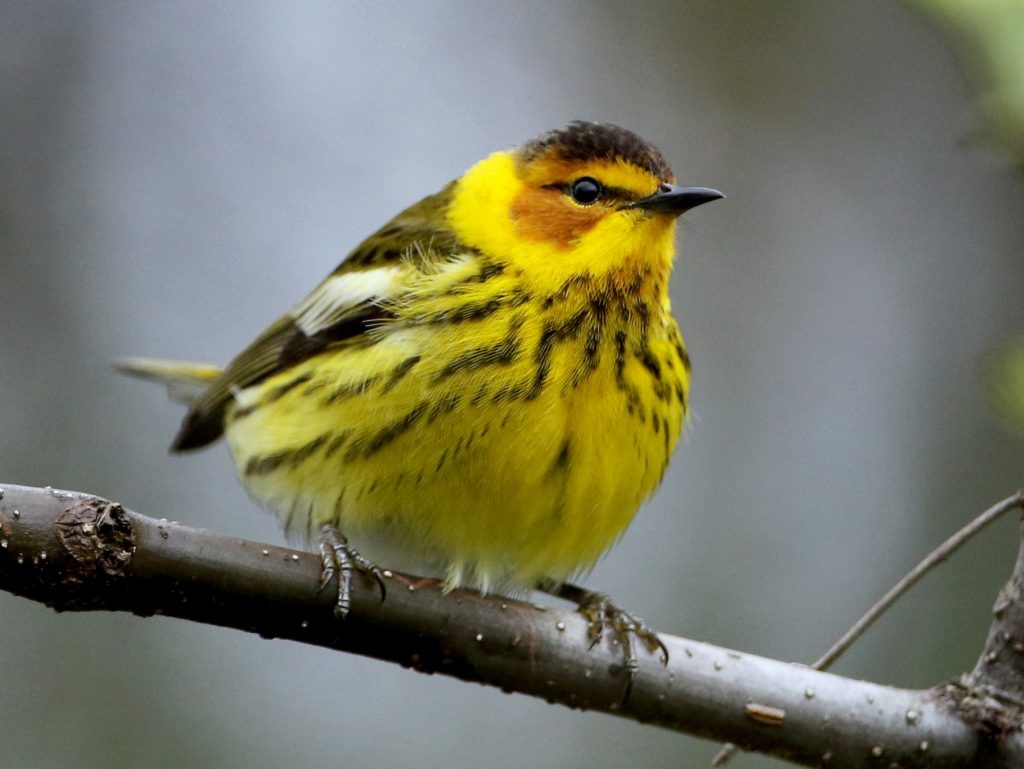
Cape May Warblers are typically observed during spring migration (April to May) and fall migration (September to October) in North Carolina, appearing in up to 11% of checklists during these times.
With chestnut cheeks, dark caps, and a distinctive yellow neck ring, male Cape May Warblers capture attention. Their bodies showcase a mottled yellow-olive coloration with dark streaks on their undersides. In comparison, females exhibit a less vibrant appearance.
Setophaga tigrina
Size: 4.7-5.1 in (12-13 cm)
Weight: 0.4-0.5 oz (10.2-15.2 g)
Wingspan: 7.9-8.7 in (20-22 cm)
Cape
May Warblers breed across Canada and northeastern US states, migrating over eastern US states. They spend the winter in the Caribbean, along a narrow coastal band on the Yucatan Peninsula, and in Central America.
While their breeding grounds reside in spruce forests, Cape May Warblers can be spotted in various habitats during migration, particularly near woods and scrub, where they can find abundant insects.
During summer, their diet primarily consists of spruce budworms, while in winter, they consume fruits, nectar, and occasionally visit hummingbird feeders.
Cape May Warbler nests are typically built high in spruce trees, near the trunk. Composed of twigs, pine needles, bark, and held together with spider webs and insect silk, the nests are lined with animal hair, feathers, and soft plant materials. They lay up to nine eggs.
To attract Cape May Warblers to your backyard, incorporate native shrubs and trees that attract insects. Fruit and hummingbird feeders can also serve as enticements.
Fun Fact: Cape May Warblers possess uniquely shaped tongues, allowing them to lap up nectar by curling their tongues into a tube-like structure.
21. Baltimore Oriole Female
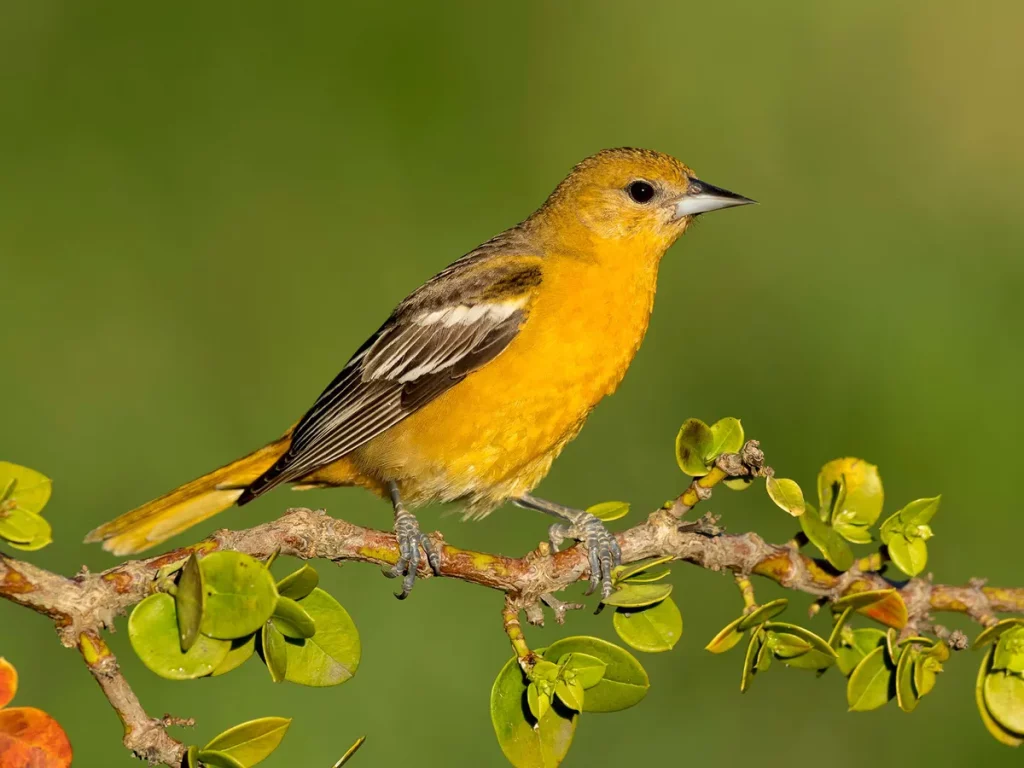
During the summer months, Baltimore Orioles can be seen in western North Carolina, with occasional sightings during migration in the eastern part of the state.
Baltimore Orioles, colorful harbingers of spring in eastern North America, exhibit bright orange and black plumage with white wing bars on their black wings in adult males.
Females feature yellowish undersides and heads, with grayish-brown wings and backs. Comparable in size to Robins, they belong to the blackbird family, boasting a slender physique.
Icterus galbula
Size: 6.7-7.5 in (17-19 cm)
Weight: 1.1-1.4 oz (30-40 g)
Wingspan: 9.1-11.8 in (23-30 cm)
Baltimore Orioles breed in Eastern and Central States, including central-southern Canadian provinces and the US southern border.
In winter, Baltimore Orioles migrate to Florida, Central America, and the Caribbean, departing as early as July.
Baltimore Orioles can be found in open woodlands, along riverbanks, and forest edges, where they hunt for insects and consume fruit. They are also known to frequent parks and backyards.
Their diet primarily consists of insects like beetles, crickets, grasshoppers, spiders, and snails. While they contribute to pest control, they may also cause damage to crops such as raspberries, mulberries, cherries, bananas, and oranges.
Baltimore Oriole sounds: The melodious flute-like songs of Baltimore Orioles herald the arrival of spring, accompanied by chattering and sharp alarm calls.
Christopher McPherson, XC690956. Accessible at www.xeno-canto.org/690956.
To attract Baltimore Orioles to your backyard, provide halved oranges on a platform feeder or hang them from trees. Additionally, oriole feeders filled with sugar water can be enticing. Planting native shrubs and trees that bear fruit and nectar, such as raspberries, crab apples, and trumpet vines, can also attract them.
Fun Fact: Baltimore Orioles construct incredible hanging bag-like nests woven from various fibers.
22. Yellow Warbler
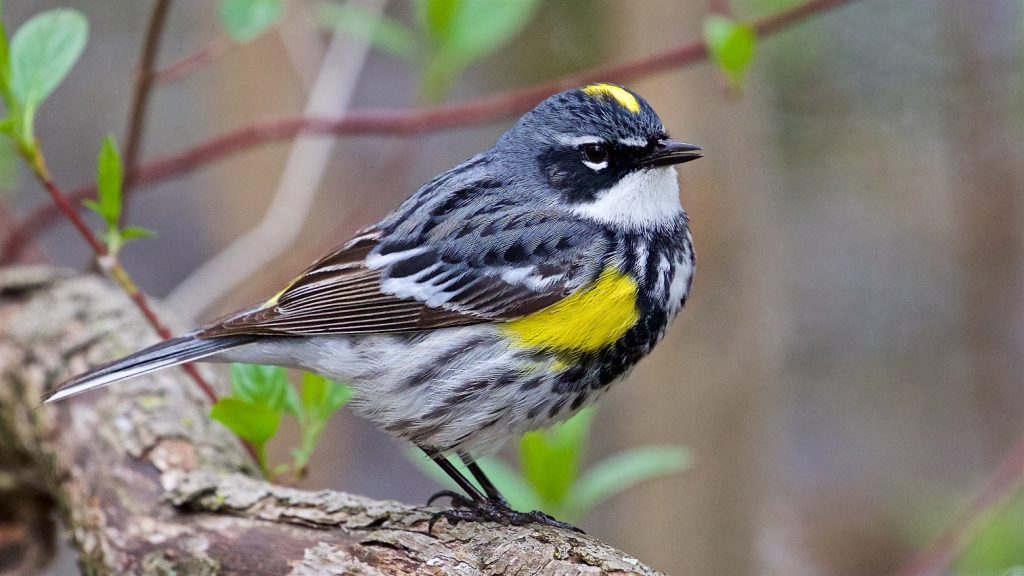
Throughout summer, Yellow Warblers grace North Carolina, appearing in 2% of checklists. They are predominantly observed from mid-April to mid-October.
Yellow Warblers present as small, brightly yellow-colored birds with a yellow-green back. Males showcase chestnut streaks on their breasts, while females and juveniles exhibit less vibrant hues.
Setophaga petechia
Size: 4.7-5.1 in (12-13 cm)
Weight: 0.3-0.4 oz (9-11 g)
Wingspan: 6.3-7.9 in (16-20 cm)
Yellow Warblers undertake extensive migrations, breeding in Canada and the US, excluding southeastern states. They then venture into Central and South America for winter, with occasional sightings during migration in southeastern US states.
Yellow Warblers can be spotted along streams, in wetlands, thickets, and field edges, where they forage for insects like caterpillars, midges, beetles, bugs, and wasps.
Yellow Warbler Song:
Credit: Richard E. Webster, XC662546. Accessible at www.xeno-canto.org/662546.
Their nests are constructed in small trees or shrubs, woven from bark, grass, and plant materials held together with spider webs. Soft materials like hair, feathers, and plant down line the cup-shaped nest.
They lay up to seven eggs, requiring around twelve days to hatch, followed by another ten days before the fledglings leave the nest.
To attract Yellow Warblers to your backyard, offer suet, oranges, and peanut butter. Planting native shrubs, trees, and berry-bearing plants can also entice them. It’s crucial to avoid pesticides and maintain a natural, insect-friendly environment. Birdbaths with fountains, located near secluded planting areas, can provide protection and water sources.
Fun Fact: When Cowbirds lay their eggs in Yellow Warblers’ nests, the Yellow Warblers detect the intrusion and construct new nests on top, repeating the process up to six times!
23. Canada Warbler

From mid-April to October, Canada Warblers make occasional appearances in North Carolina, accounting for 2% of summer checklists.
Canada Warblers bear resemblance to Magnolia Warblers and share a similar range. However, they feature a grayish-black back, and the black “necklace” in males extends only over the chest, not the belly. They possess yellow chests, bellies, and throats.
Females and immature Canada Warblers exhibit similar markings but with paler backs and less prominent “necklaces.”
Cardellina canadensis
Size: 4.7-5.9 in (12-15 cm)
Weight: 0.3-0.5 oz (9-13 g)
Wingspan: 6.7-8.7 in (17-22 cm)
Canada Warblers breed in Canada and northeastern US states. During migration, they traverse the eastern half of the US, while spending winters in western South America.
Canada Warblers can be found foraging for insects and spiders in rhododendron-filled conifer forests, aspen, poplar forests, and similar habitats. These warblers’ numbers have been declining, making them elusive to locate.
Canada Warbler song:
Credit: Peter Ward and Ken Hall, XC512275. Accessible at www.xeno-canto.org/512275.
Nests of Canada Warblers are built close to the ground, hidden in shrubs or ferns. Constructed from grass, bark, leaves, and other plant materials, the nests form a cup shape. They lay up to six eggs, which require around twelve days to hatch, followed by eight more days before the young leave the nest.
Fun Fact: Canada Warblers embark on impressive journeys, covering over 3,000 miles each way between their winter and summer grounds.
24. Orange-crowned Warbler
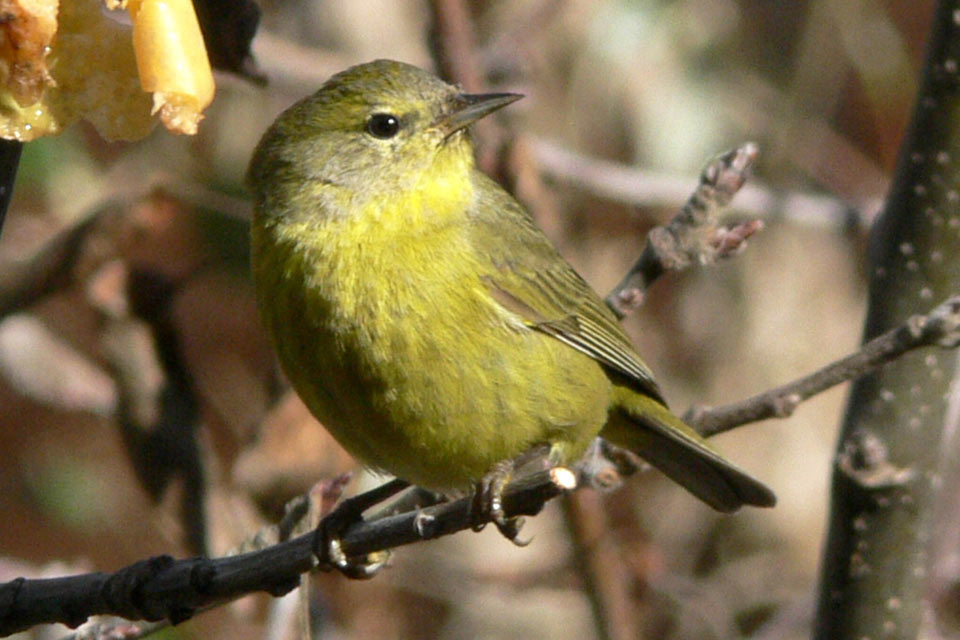
Orange-crowned Warblers spend their winters in North Carolina, observed from September until May. They account for 1% of checklists during this period.
Orange-crowned Warblers don’t display as vibrant colors as other warbler species. They primarily exhibit olive-green or grayish-brown plumage with a yellowish tinge on their undertail coverts.
Oreothlypis celata
Size: 4.7-5.1 in (12-13 cm)
Weight: 0.3-0.4 oz (9-12 g)
Wingspan: 7.1-7.9 in (18-20 cm)
During summer, Orange-crowned Warblers breed in the northwestern US and Canada, including Alaska. Their winter range extends from the southern US to Mexico and Central America.
Orange-crowned Warblers occupy a wide variety of habitats, including forests, shrubby areas, and gardens. They primarily feed on insects, spiders, and berries.
Their nests are built on the ground or low in shrubs, constructed from grass, moss, bark, and other plant materials. Lined with fine grass and feathers, the nests hold up to six eggs, which take around twelve days to hatch.
Fun Fact: The orange crown, from which they derive their name, is often concealed and rarely visible.
25. Wilson’s Warbler
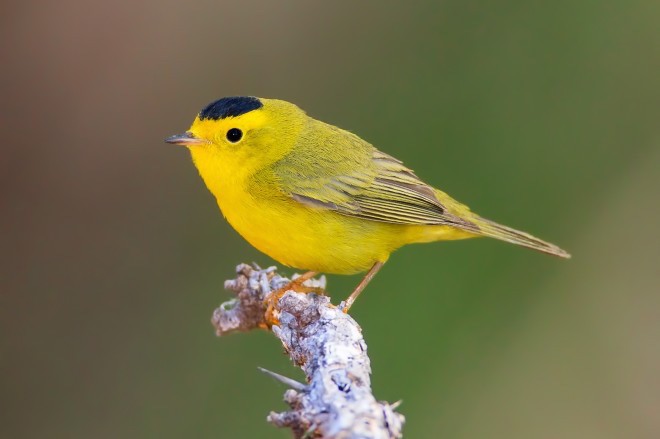
Wilson’s Warblers visit North Carolina during migration, from late April to early May and late August to late September, appearing on 2% of checklists.
Male Wilson’s Warblers exhibit striking black caps and vibrant yellow faces, throats, and bellies. Their olive-green backs feature streaks, while females showcase similar patterns but with a duller yellow coloration.
Cardellina pusilla
Size: 4.3-4.7 in (11-12 cm)
Weight: 0.3-0.4 oz (8-12 g)
Wingspan: 6.7-7.5 in (17-19 cm)
Wilson’s Warblers breed in Canada, Alaska, and the northwestern US. During migration, they traverse the western and central US before wintering in Mexico, Central America, and northern South America.
Wilson’s Warblers prefer moist habitats, including streamside vegetation, wetlands, and thickets. They forage for insects, spiders, and small fruits.
Nests are typically built on the ground, hidden in grass, moss, or low shrubs. Constructed from grass, bark strips, and other plant materials, the nests are lined with fine grass and hair. Wilson’s Warblers lay up to six eggs, requiring around twelve days to hatch.
26. Connecticut Warbler
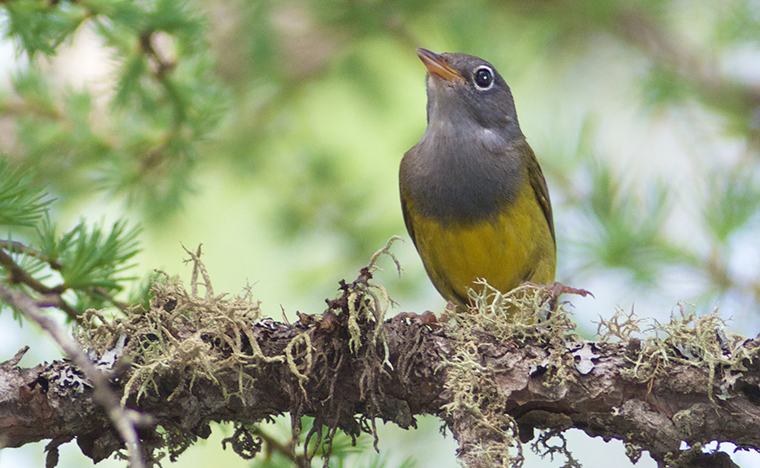
Connecticut Warblers are rare migrants in North Carolina, with occasional sightings during spring and fall migration. They are known for their secretive behavior, making them challenging to observe.
Oporornis agilis
Size: 5.1-5.9 in (13-15 cm)
Weight: 0.4-0.5 oz (12-14 g)
Wingspan: 8.7-9.8 in (22-25 cm)
Connecticut Warblers breed in the boreal forests of Canada and the northern US. During migration, they pass through the central and eastern US before wintering in northern South America.
These warblers prefer dense thickets, especially those with a mix of deciduous and coniferous trees. They primarily feed on insects and berries.
Connecticut Warblers build their nests on the ground, concealed in dense vegetation. The nests are constructed from leaves, grass, and moss, lined with finer materials. They lay around four to six eggs, which take approximately two weeks to hatch.
27. Kentucky Warbler

Kentucky Warblers are uncommon but regular summer residents in North Carolina. They arrive in late April and depart by early October.
Geothlypis formosa
Size: 5.5-6.3 in (14-16 cm)
Weight: 0.5-0.6 oz (14-17 g)
Wingspan: 7.9-9.1 in (20-23 cm)
Kentucky Warblers breed in the southeastern US, including parts of North Carolina, and also in the Midwest. They prefer moist deciduous forests, bottomlands, and dense undergrowth near streams.
These warblers feed on insects, spiders, and occasionally berries.
Kentucky Warbler song:
Credit: Mike Nelson, XC207707. Accessible at www.xeno-canto.org/207707.
Their nests are built on the ground or in leaf litter, concealed among shrubs or vegetation. Constructed from leaves, bark, and grass, the nests are lined with fine materials. Kentucky Warblers lay around three to five eggs, with an incubation period of approximately two weeks.
Fun Fact: Kentucky Warblers are known for their distinctive, loud, and repetitive song, often described as sounding like “tory-tory-tory.”
28. Mourning Warbler
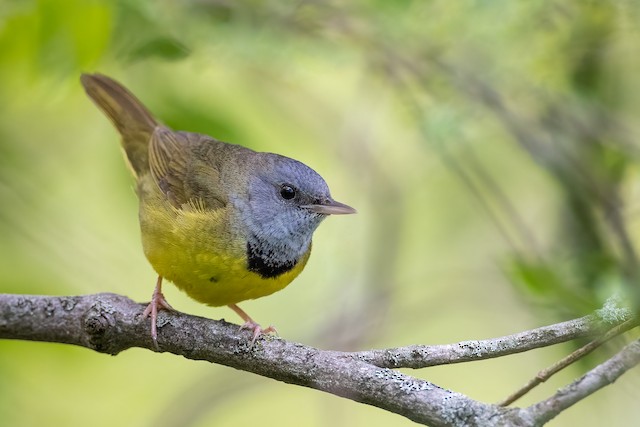
Mourning Warblers are infrequent migrants in North Carolina, passing through the state during spring and fall migration. They have a preference for dense, shrubby habitats.
Geothlypis philadelphia
Size: 4.7-5.5 in (12-14 cm)
Weight: 0.3-0.4 oz (9-12 g)
Wingspan: 7.5-8.7 in (19-22 cm)
Mourning Warblers breed in the boreal forests of Canada and the northern US. During migration, they traverse the central and eastern US before reaching their wintering grounds in Mexico, Central America, and northern South America.
These warblers can be found in damp thickets, second-growth forests, and shrubby areas near wetlands. They primarily feed on insects and occasionally berries.
Mourning Warblers build their nests on or near the ground, concealed in dense vegetation. Constructed from grass, leaves, and plant stems, the nests are lined with finer materials. They lay around three to five eggs, with an incubation period of approximately two weeks.
Fun Fact: Mourning Warblers get their name from their mournful-sounding song, which consists of a series of low, whistled notes.
Note: The information provided here is based on general knowledge about bird species. For accurate and up-to-date information, consult field guides, birding resources, or organizations dedicated to ornithology.